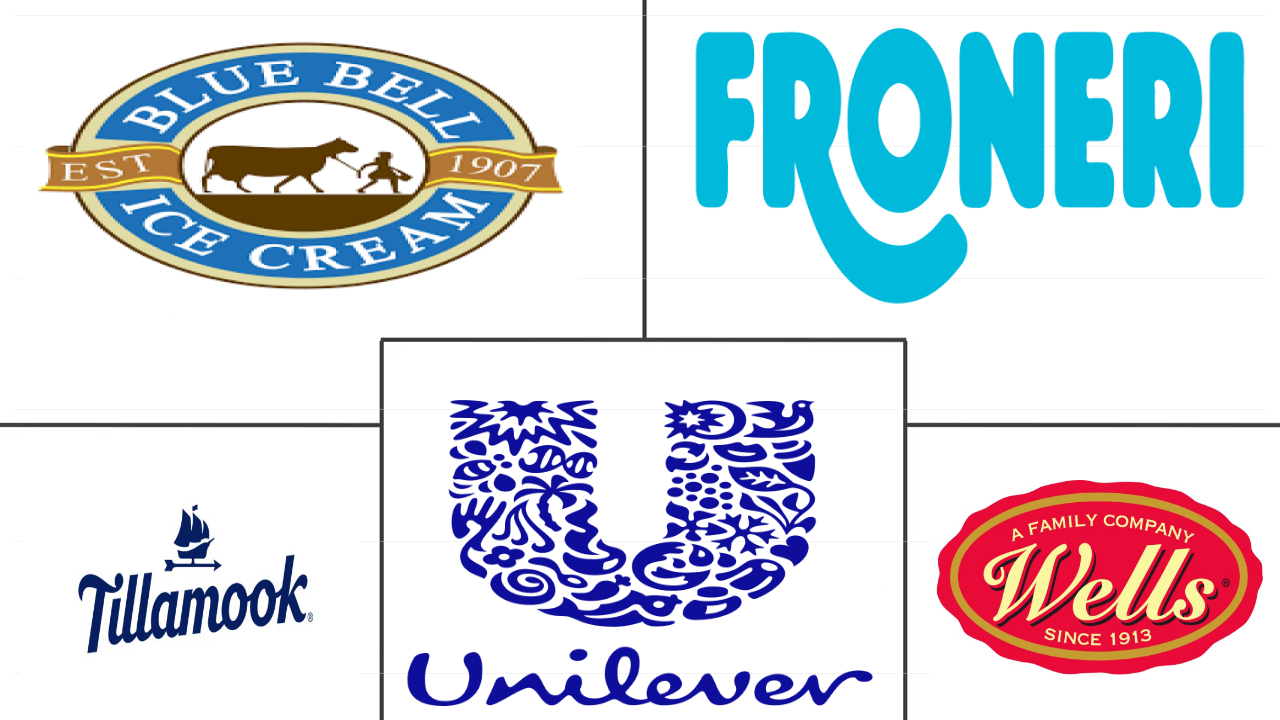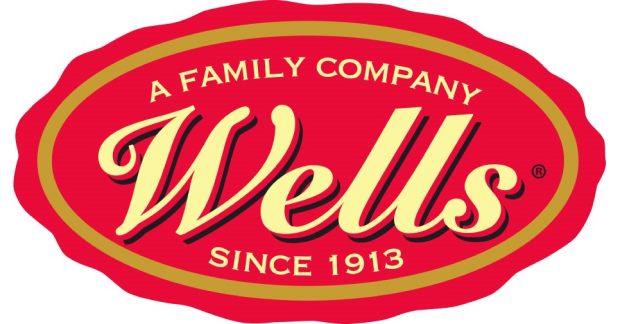United States Ice Cream Market Size
|
|
Study Period | 2017 - 2029 |
|
|
Market Size (2024) | USD 19.03 Billion |
|
|
Market Size (2029) | USD 21.76 Billion |
|
|
Largest Share by Distribution Channel | Off-Trade |
|
|
CAGR (2024 - 2029) | 2.72 % |
|
|
Fastest Growing by Distribution Channel | Off-Trade |
Major Players |
||

|
||
|
*Disclaimer: Major Players sorted in no particular order |
United States Ice Cream Market Analysis
The United States Ice Cream Market size is estimated at 19.03 billion USD in 2024, and is expected to reach 21.76 billion USD by 2029, growing at a CAGR of 2.72% during the forecast period (2024-2029).
19.03 Billion
Market Size in 2024 (USD)
21.76 Billion
Market Size in 2029 (USD)
2.04 %
CAGR (2017-2023)
2.72 %
CAGR (2024-2029)
Leading Market Player
20.73 %
market share, Unilever PLC, 2022

The products offered by Unilever group have various national and international certifications, making it unique in the country and helping it maintain its market share.
Largest Market by Distribution Channel
93.92 %
value share, Off-Trade, 2023
The wider availability of various brands, ease of reading product labels and convenience in comparing different products make it the preffered type among the dairy consumers.
Fastest-growing Market by Distribution Channel
2.73 %
Projected CAGR, Off-Trade, 2024-2029
The rising preference to buy essential groceries online during the pandemic drove the off-trade channel. The growth is also assisted by better consumer reach through digital marketing.
Second leading Market Player
13.72 %
market share, Froneri International Limited, 2022

Froneri Ltd's wide range of offerings in the country, along with the increasing dairy products manufacturing units, is highly supporting its market growth and domination.
Third Leading Market Player
2.85 %
market share, Wells Enterprises Inc., 2022

The product lineup which includes Blue Bell Ice Cream, Light Ice Cream, No Sugar Added Ice Cream and Sherbet along with wider distribution is captivating the market growth.
Revitalized stores, enhanced supply chains propel supermarkets and hypermarkets to witness surge in ice cream sales
- In 2020, the on-trade segment was significantly impacted by the COVID-19 pandemic due to lockdowns imposed worldwide. Despite these challenges, US consumers spent an average of 8.6% of their disposable personal income on food in 2020. This amount was split between meals consumed at home (5.0%) and away from home (3.6%). However, restaurants, bars, and casinos had to shut down operations in the country. Therefore, the on-trade sales value of ice cream decreased by 14% in 2020 compared to 2019, with around 32,109 restaurants shutting operations during the pandemic.
- The online retail channel is expected to be the fastest-growing distribution sub-segment in the off-trade segment. It is projected to register a growth value of 13% during 2023-2028 due to the increasing number of smartphone users, which rose by 11 million between 2020 and 2021. Around 45% of the US population browses online websites through mobile devices. The sales of ice cream through online channels increased by 6% during 2018-2021.
- In the off-trade segment, consumers prefer buying ice cream from supermarkets/hypermarkets, as the country is home to a large number of supermarkets. Currently, there are 63,419 supermarkets in the United States. Supermarket sales for ice cream in the United States grew by 3% in terms of value from 2018 to 2021. About 60% of mass players and large national supermarket retailers in the United States invested in 2020 to improve their ability to better personalize promotions and pricing by strategizing on significant price drops, store remodels, and supply chain investments. Several supermarket chains also introduced click-and-collect and delivery services through third-party providers.
United States Ice Cream Market Trends
The increasing influence of innovative flavors is impacting the consumption of ice cream in the United States
- The increasing preference of consumers for premium ice creams and intercontinental flavors has led to a sharp increase in the per capita consumption of ice cream in the United States during the last decades. In 2022, per capita consumption of ice cream increased by 1.3% compared to the previous year, 2021. Consumers purchase ice cream in large cartons as well as individually wrapped frozen novelties that include ice-cream sandwiches, ice cream cones, chocolate-dipped bars, Klondike bars, and popsicles. Approximately 87% of the US population has ice cream in their freezers at any time, while Sunday is the most common day for them to purchase ice cream.
- Ice creams with low-calorie (150 calories per serving) or no-sugar options compared to regular ice creams have gained popularity among health-conscious consumers. Due to this, regular ice cream consumption experienced a dip of 9% up to 2021, compared to the historical years, while low-fat ice cream consumption increased by 20%. As of 2021, almost 74% of the US population eats ice cream at least once a week, which they also like to eat at home, while 84% of the US population purchased ice cream at grocery stores and ate it at home.
- Popular flavors of ice cream in the United States include vanilla, chocolate, strawberry, butter pecan, and mint chocolate chip. Despite this, chocolate remains the favorite among consumers. In 2021, 17% of US consumers preferred the chocolate flavor, followed by vanilla with 15%, and strawberry and mint chocolate chip with 8% each. Almost half of the consumers bought ice cream in half-gallon containers, and about 23% preferred to buy pints.
OTHER KEY INDUSTRY TRENDS COVERED IN THE REPORT
- Growth in milk volume per cow is among the factors largely boosting milk production in the country
United States Ice Cream Industry Overview
The United States Ice Cream Market is moderately consolidated, with the top five companies occupying 41.56%. The major players in this market are Blue Bell Creameries LP, Froneri International Limited, Tilamook CCA, Unilever PLC and Wells Enterprises Inc. (sorted alphabetically).
United States Ice Cream Market Leaders
Blue Bell Creameries LP
Froneri International Limited
Tilamook CCA
Unilever PLC
Wells Enterprises Inc.
Other important companies include Dairy Farmers of America Inc., Focus Brands LLC, Giffords Dairy Inc., Turkey Hill Dairy, Van Leeuwen Ice Cream.
*Disclaimer: Major Players sorted in alphabetical order.
United States Ice Cream Market News
- October 2022: Unilever partnered with ASAP for the delivery of its ice cream products. As per the partnership, ASAP will also deliver ice cream and treats from Unilever's virtual storefront, The Ice Cream Shop.
- October 2022: Kemps replaced Dean Goods throughout Iowa as Dairy Farmers of America completed the USD 433 million acquisition of Dean Foods properties. The business took over the Le Mars milk factory, which can process numerous Kemps products, from cottage cheese to ice cream.
- October 2022: Blue Ribbon's Street range launched three new two-liter tubs, each featuring two flavors. The range includes chocolate affair, caramel hokey pokey, and velvety caramel.
Free with this Report
We provide a comprehensive and exhaustive set of data pointers for global, regional, and country-level metrics that illustrate the fundamentals of the dairy industry. With the help of 45+ free charts, clients can access in-depth market analysis based on per capita consumption numbers and production data of raw materials for dairy, through granular-level segmental information supported by a repository of market data, trends, and expert analysis. Data and analysis on dairy, categories of dairy products, product types, etc., are available in the form of comprehensive reports as well as excel based data worksheets.
United States Ice Cream Market Report - Table of Contents
1. EXECUTIVE SUMMARY & KEY FINDINGS
2. REPORT OFFERS
3. INTRODUCTION
- 3.1 Study Assumptions & Market Definition
- 3.2 Scope of the Study
- 3.3 Research Methodology
4. KEY INDUSTRY TRENDS
- 4.1 Per Capita Consumption
-
4.2 Raw Material/commodity Production
- 4.2.1 Milk
-
4.3 Regulatory Framework
- 4.3.1 United States
- 4.4 Value Chain & Distribution Channel Analysis
5. MARKET SEGMENTATION (includes market size in Value in USD and Volume, Forecasts up to 2029 and analysis of growth prospects)
-
5.1 Distribution Channel
- 5.1.1 Off-Trade
- 5.1.1.1 Convenience Stores
- 5.1.1.2 Online Retail
- 5.1.1.3 Specialist Retailers
- 5.1.1.4 Supermarkets and Hypermarkets
- 5.1.1.5 Others (Warehouse clubs, gas stations, etc.)
- 5.1.2 On-Trade
6. COMPETITIVE LANDSCAPE
- 6.1 Key Strategic Moves
- 6.2 Market Share Analysis
- 6.3 Company Landscape
-
6.4 Company Profiles (includes Global Level Overview, Market Level Overview, Core Business Segments, Financials, Headcount, Key Information, Market Rank, Market Share, Products and Services, and Analysis of Recent Developments).
- 6.4.1 Blue Bell Creameries LP
- 6.4.2 Dairy Farmers of America Inc.
- 6.4.3 Focus Brands LLC
- 6.4.4 Froneri International Limited
- 6.4.5 Giffords Dairy Inc.
- 6.4.6 Tilamook CCA
- 6.4.7 Turkey Hill Dairy
- 6.4.8 Unilever PLC
- 6.4.9 Van Leeuwen Ice Cream
- 6.4.10 Wells Enterprises Inc.
7. KEY STRATEGIC QUESTIONS FOR DAIRY AND DAIRY ALTERNATIVE CEOS
8. APPENDIX
-
8.1 Global Overview
- 8.1.1 Overview
- 8.1.2 Porter’s Five Forces Framework
- 8.1.3 Global Value Chain Analysis
- 8.1.4 Market Dynamics (DROs)
- 8.2 Sources & References
- 8.3 List of Tables & Figures
- 8.4 Primary Insights
- 8.5 Data Pack
- 8.6 Glossary of Terms
List of Tables & Figures
- Figure 1:
- PER CAPITA CONSUMPTION OF ICE CREAM, KG, UNITED STATES, 2017 - 2029
- Figure 2:
- PRODUCTION OF MILK, METRIC TONNES, UNITED STATES, 2017 - 2021
- Figure 3:
- VOLUME OF ICE CREAM, METRIC TONNES, BY UNITED STATES, 2017 - 2029
- Figure 4:
- VALUE OF ICE CREAM, USD MN, BY UNITED STATES, 2017 - 2029
- Figure 5:
- VOLUME OF ICE CREAM MARKET BY DISTRIBUTION CHANNEL, METRIC TONNES, UNITED STATES, 2017 - 2029
- Figure 6:
- VALUE OF ICE CREAM MARKET BY DISTRIBUTION CHANNEL, USD MN, UNITED STATES, 2017 - 2029
- Figure 7:
- VOLUME SHARE OF ICE CREAM MARKET, BY DISTRIBUTION CHANNEL , %, UNITED STATES, 2017 VS 2023 VS 2029
- Figure 8:
- VALUE SHARE OF ICE CREAM MARKET, BY DISTRIBUTION CHANNEL , %, UNITED STATES, 2017 VS 2023 VS 2029
- Figure 9:
- VOLUME OF ICE CREAM MARKET BY SUB DISTRIBUTION CHANNELS, METRIC TONNES, UNITED STATES, 2017 - 2029
- Figure 10:
- VALUE OF ICE CREAM MARKET BY SUB DISTRIBUTION CHANNELS, USD MN, UNITED STATES, 2017 - 2029
- Figure 11:
- VOLUME SHARE OF ICE CREAM MARKET, BY SUB DISTRIBUTION CHANNELS , %, UNITED STATES, 2017 VS 2023 VS 2029
- Figure 12:
- VALUE SHARE OF ICE CREAM MARKET, BY SUB DISTRIBUTION CHANNELS , %, UNITED STATES, 2017 VS 2023 VS 2029
- Figure 13:
- VOLUME OF ICE CREAM MARKET SOLD VIA CONVENIENCE STORES, METRIC TONNES, UNITED STATES, 2017 - 2029
- Figure 14:
- VALUE OF ICE CREAM MARKET SOLD VIA CONVENIENCE STORES, USD MN, UNITED STATES, 2017 - 2029
- Figure 15:
- VOLUME OF ICE CREAM MARKET SOLD VIA ONLINE RETAIL, METRIC TONNES, UNITED STATES, 2017 - 2029
- Figure 16:
- VALUE OF ICE CREAM MARKET SOLD VIA ONLINE RETAIL, USD MN, UNITED STATES, 2017 - 2029
- Figure 17:
- VOLUME OF ICE CREAM MARKET SOLD VIA SPECIALIST RETAILERS, METRIC TONNES, UNITED STATES, 2017 - 2029
- Figure 18:
- VALUE OF ICE CREAM MARKET SOLD VIA SPECIALIST RETAILERS, USD MN, UNITED STATES, 2017 - 2029
- Figure 19:
- VOLUME OF ICE CREAM MARKET SOLD VIA SUPERMARKETS AND HYPERMARKETS, METRIC TONNES, UNITED STATES, 2017 - 2029
- Figure 20:
- VALUE OF ICE CREAM MARKET SOLD VIA SUPERMARKETS AND HYPERMARKETS, USD MN, UNITED STATES, 2017 - 2029
- Figure 21:
- VOLUME OF ICE CREAM MARKET SOLD VIA OTHERS (WAREHOUSE CLUBS, GAS STATIONS, ETC.), METRIC TONNES, UNITED STATES, 2017 - 2029
- Figure 22:
- VALUE OF ICE CREAM MARKET SOLD VIA OTHERS (WAREHOUSE CLUBS, GAS STATIONS, ETC.), USD MN, UNITED STATES, 2017 - 2029
- Figure 23:
- VOLUME OF ICE CREAM MARKET SOLD VIA ON-TRADE, METRIC TONNES, UNITED STATES, 2017 - 2029
- Figure 24:
- VALUE OF ICE CREAM MARKET SOLD VIA ON-TRADE, USD MN, UNITED STATES, 2017 - 2029
- Figure 25:
- MOST ACTIVE COMPANIES BY NUMBER OF STRATEGIC MOVES, COUNT, UNITED STATES, 2017 - 2029
- Figure 26:
- MOST ADOPTED STRATEGIES, COUNT, UNITED STATES, 2017 - 2029
- Figure 27:
- VALUE SHARE OF MAJOR PLAYERS, %, UNITED STATES, 2022
United States Ice Cream Industry Segmentation
Off-Trade, On-Trade are covered as segments by Distribution Channel.
- In 2020, the on-trade segment was significantly impacted by the COVID-19 pandemic due to lockdowns imposed worldwide. Despite these challenges, US consumers spent an average of 8.6% of their disposable personal income on food in 2020. This amount was split between meals consumed at home (5.0%) and away from home (3.6%). However, restaurants, bars, and casinos had to shut down operations in the country. Therefore, the on-trade sales value of ice cream decreased by 14% in 2020 compared to 2019, with around 32,109 restaurants shutting operations during the pandemic.
- The online retail channel is expected to be the fastest-growing distribution sub-segment in the off-trade segment. It is projected to register a growth value of 13% during 2023-2028 due to the increasing number of smartphone users, which rose by 11 million between 2020 and 2021. Around 45% of the US population browses online websites through mobile devices. The sales of ice cream through online channels increased by 6% during 2018-2021.
- In the off-trade segment, consumers prefer buying ice cream from supermarkets/hypermarkets, as the country is home to a large number of supermarkets. Currently, there are 63,419 supermarkets in the United States. Supermarket sales for ice cream in the United States grew by 3% in terms of value from 2018 to 2021. About 60% of mass players and large national supermarket retailers in the United States invested in 2020 to improve their ability to better personalize promotions and pricing by strategizing on significant price drops, store remodels, and supply chain investments. Several supermarket chains also introduced click-and-collect and delivery services through third-party providers.
| Distribution Channel | Off-Trade | Convenience Stores |
| Online Retail | ||
| Specialist Retailers | ||
| Supermarkets and Hypermarkets | ||
| Others (Warehouse clubs, gas stations, etc.) | ||
| Distribution Channel | On-Trade |
Market Definition
- Butter - Butter is a yellow-to-white solid emulsion of fat globules, water, and inorganic salts produced by churning the cream from cows’ milk
- Dairy - Dairy product include milk and any of the foods made from milk, including butter, cheese, ice cream, yogurt, and condensed and dried milk.
- Frozen Desserts - Frozen dairy dessert means and includes products containing milk or cream and other ingredients which are frozen or semi-frozen prior to consumption, such as ice milk or sherbet, including frozen dairy desserts for special dietary purposes, and sorbet
- Sour Milk Drinks - Sour milk is thick, curdled milk, with a sour taste, obtained from the fermentation of milk. Sour milk drinks such as kefir, laban, buttermilk have been considered in the study
| Keyword | Definition |
|---|---|
| Cultured Butter | Cultured butter is prepared by having the raw butter go through chemical processing and has been added with certain emulsifiers and foreign ingredients. |
| Uncultured Butter | This type of butter is one which has not been processed in any way |
| Natural Cheese | The type of cheese in its most natural form. It is made from natural and simple products and ingredients, including fresh and natural salts, natural colors, enzymes, and high-quality milk. |
| Processed Cheese | Processed cheese undergoes the same processes as natural cheese; however, it requires more steps and many different forms of ingredients. Making processed cheese involves melting natural cheese, emulsifying it, and adding preservatives and other artificial ingredients or colorings. |
| Single Cream | Single cream contains around 18% fat. It’s a single layer of cream that appears over boiled milk. |
| Double Cream | Double cream contains 48% fat, more than double the amount of fat of single cream. It’s heavier and thicker than single cream |
| Whipping Cream | This has a much higher fat percentage than single cream (36%). Used to top cakes, pies, and puddings and as a thickener for sauces, soups, and fillings. |
| Frozen Desserts | Desserts that are meant to be eaten in frozen condition. E.g., sherbets, sorbets, frozen yogurts |
| UHT Milk (Ultra-high temperature milk) | Milk heated at a very high temperature. Ultra-high-temperature processing (UHT) of milk involves heating for 1–8 sec at 135–154°C. which kills the spore-forming pathogenic microorganism, resulting in a product with a shelf-life of several months. |
| Non-dairy butter/Plant-based butter | Butter made from plant-derived oil such as coconut, palm, etc. |
| Non-dairy Yogurt | Yogurt made from typically made from nuts, like almonds, cashews, coconuts, and even other foods like soybeans, plantains, oats, and peas |
| On-trade | It refers to restaurants, QSRs, and bars. |
| Off-trade | It refers to supermarkets, hypermarkets, on-line channels, etc. |
| Neufchatel cheese | One of the oldest kinds of cheese in France. It is a soft, slightly crumbly, mold-ripened, bloomy-rind cheese made in the Neufchâtel-en-Bray region of Normandy. |
| Flexitarian | It refers to a consumer preferring a semi-vegetarian diet, that is centered on plant foods with limited or occasional inclusion of meat. |
| Lactose Intolerance | Lactose intolerance is a reaction in digestive system to lactose, the sugar in milk. It causes uncomfortable symptoms in response to the consumption of dairy products. |
| Cream Cheese | Cream cheese is a soft and creamy fresh cheese with a tangy taste made from milk and cream. |
| Sorbets | Sorbet is a frozen dessert made using ice combined with fruit juice, fruit purée, or other ingredients, such as wine, liqueur, or honey. |
| Sherbet | Sherbet is a sweetened frozen dessert made with fruit and some sort of dairy product such as milk or cream. |
| Shelf stable | Foods that can be safely stored at room temperature, or "on the shelf," for at least one year and do not have to be cooked or refrigerated to eat safely. |
| DSD | Direct Store Delivery is the process in supply chain management wherein the product is delivered from manufacturing plant directly to the retailer. |
| OU Kosher | Orthodox Union Kosher is a kosher certification agency based in New York City. |
| Gelato | Gelato is a frozen creamy dessert made with milk, heavy cream and sugar. |
| Grass-fed Cows | Grass-fed cows are allowed to graze in pastures, where they eat a variety of grasses and clover. |
Research Methodology
Mordor Intelligence follows a four-step methodology in all our reports.
- Step-1: Identify Key Variables: In order to build a robust forecasting methodology, the variables and factors identified in Step 1 are tested against available historical market numbers. Through an iterative process, the variables required for market forecast are set, and the model is built on the basis of these variables.
- Step-2: Build a Market Model: Market-size estimations for the forecast years are in nominal terms. Inflation is not a part of the pricing, and the average selling price (ASP) is kept constant throughout the forecast period for each country.
- Step-3: Validate and Finalize: In this important step, all market numbers, variables, and analyst calls are validated through an extensive network of primary research experts from the market studied. The respondents are selected across levels and functions to generate a holistic picture of the market studied.
- Step-4: Research Outputs: Syndicated Reports, Custom Consulting Assignments, Databases & Subscription Platforms








